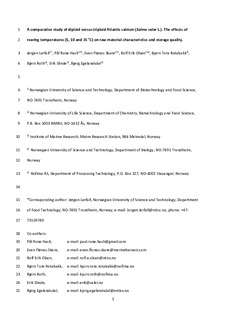| dc.contributor.author | Lerfall, Jørgen | |
| dc.contributor.author | Hasli, Pål Rune | |
| dc.contributor.author | Skare, Even Flønes | |
| dc.contributor.author | Olsen, Rolf Erik | |
| dc.contributor.author | Rotabakk, Bjørn Tore | |
| dc.contributor.author | Roth, Bjørn | |
| dc.contributor.author | Slinde, Erik | |
| dc.contributor.author | Egelandsdal, Bjørg Tordis | |
| dc.date.accessioned | 2018-01-02T08:38:57Z | |
| dc.date.available | 2018-01-02T08:38:57Z | |
| dc.date.created | 2017-01-06T10:40:39Z | |
| dc.date.issued | 2017 | |
| dc.identifier.citation | Food Chemistry. 2017, 225 37-44. | nb_NO |
| dc.identifier.issn | 0308-8146 | |
| dc.identifier.uri | http://hdl.handle.net/11250/2473886 | |
| dc.description.abstract | Several major market operators argue that the current level of knowledge about quality is too scant to justify a switch to a large-scale production of triploid salmon. The aim of the present study was, therefore, to elucidate how rearing conditions (5, 10 and 15 °C) affect the flesh quality of triploid Atlantic salmon (Salmo salar L., 1.6 ± 0.3 kg). As a reference, diploid salmon kept under equal conditions and with equal genetics were used. The main design discriminant was the holding temperature; increased temperature gave increased blood lactate, rigor index (Ir), drip loss (DL), content of astaxanthin and intensity of redness, but reduced muscle pH, cathepsin activity and fillet lightness. Salmon kept at 10 °C grew the fastest. It is concluded that ploidy gave less variation than temperature. Triploids were characterized by lower blood haematocrit (Hct) and Ir, higher DL and collagenase activity, and on average, paler and less yellowish fillets. | nb_NO |
| dc.language.iso | eng | nb_NO |
| dc.publisher | Elsevier | nb_NO |
| dc.rights | Attribution-NonCommercial-NoDerivatives 4.0 Internasjonal | * |
| dc.rights.uri | http://creativecommons.org/licenses/by-nc-nd/4.0/deed.no | * |
| dc.title | A comparative study of diploid versus triploid Atlantic salmon (Salmo salar L.). The effects of rearing temperatures (5, 10 and 15 °C) on raw material characteristics and storage quality | nb_NO |
| dc.type | Journal article | nb_NO |
| dc.type | Peer reviewed | nb_NO |
| dc.description.version | acceptedVersion | nb_NO |
| dc.source.pagenumber | 37-44 | nb_NO |
| dc.source.volume | 225 | nb_NO |
| dc.source.journal | Food Chemistry | nb_NO |
| dc.identifier.doi | 10.1016/j.foodchem.2017.01.012 | |
| dc.identifier.cristin | 1422162 | |
| dc.relation.project | Nofima AS: 10803 | nb_NO |
| dc.relation.project | Norges forskningsråd: 233689 | nb_NO |
| dc.description.localcode | © 2017. This is the authors’ accepted and refereed manuscript to the article. Locked until 4.1.2018 due to copyright restrictions. This manuscript version is made available under the CC-BY-NC-ND 4.0 license http://creativecommons.org/licenses/by-nc-nd/4.0/ | nb_NO |
| cristin.unitcode | 194,66,15,0 | |
| cristin.unitcode | 194,66,10,0 | |
| cristin.unitname | Institutt for bioteknologi og matvitenskap | |
| cristin.unitname | Institutt for biologi | |
| cristin.ispublished | true | |
| cristin.fulltext | postprint | |
| cristin.qualitycode | 1 | |

